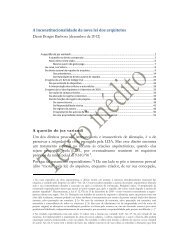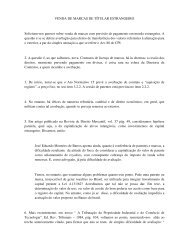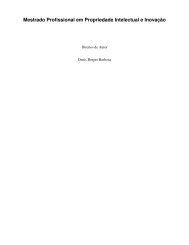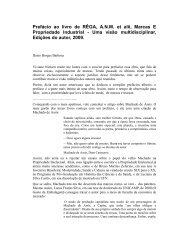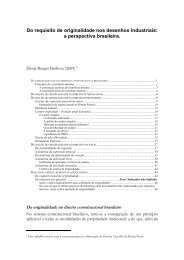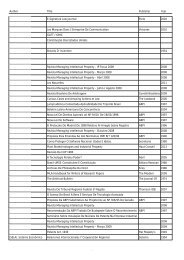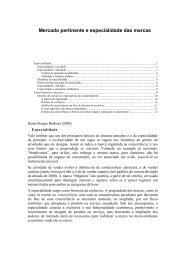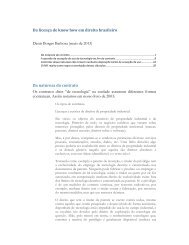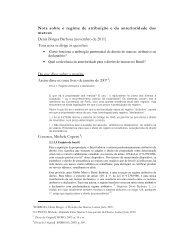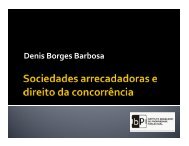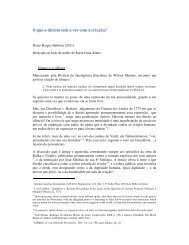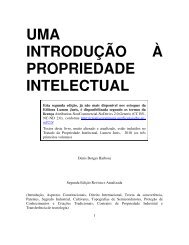Prefácio ao livro de BRUCH, Kelly Lissandra. Signos Distintivos e ...
Prefácio ao livro de BRUCH, Kelly Lissandra. Signos Distintivos e ...
Prefácio ao livro de BRUCH, Kelly Lissandra. Signos Distintivos e ...
You also want an ePaper? Increase the reach of your titles
YUMPU automatically turns print PDFs into web optimized ePapers that Google loves.
Collective ownership in IP lawIt should be noted that, although the by-laws of structured collaborative works relateessentially to authorship, they must necessarily govern ownership—be it positive, negativeor neutral. Some other IP rights may also facilitate structured open ownership.José Oliveira Ascensão indicates that un<strong>de</strong>r Portuguese law (and probably also BrazilianLaw), geographic indications (GIs) are owned by a plurality of persons, and one can becomean owner without the actual sharing of title: anyone in the assigned geographical limits maybe entitled to <strong>de</strong>fend the GI as intellectual property, provi<strong>de</strong>d that the owner follows thespecific by-laws. 9Some GIs necessitate the following of a complex set of technical rules, which arguablywould preclu<strong>de</strong> authorship. Other GIs, however, are recognised simply on account of thewell-known properties of the geographical set. 10 Well-knowness, or fame, is to the sameextent the result of a <strong>de</strong>liberate, continuous creation by the interested parties. 11Creation of fame is an essential element of tra<strong>de</strong>mark law 12 and especially publicity rights. 13Through the establishment of a consumable myth, fame is a fictional creation through a6 DIAS, Eduardo Tibau <strong>de</strong> Vasconcellos. Autoria nas Obras Colaborativas e Coletivas. 2010. Dissertação (Mestrado emProprieda<strong>de</strong> Intelectual) - Instituto Nacional da Proprieda<strong>de</strong> Industrial. Orientador: Denis Borges Barbosa.7 "Repare-se que patrimônio coletivo não é o mesmo que "proprieda<strong>de</strong> coletiva", que é o contraponto <strong>de</strong> "proprieda<strong>de</strong>privada". O patrimônio coletivo é ainda uma forma <strong>de</strong> proprieda<strong>de</strong> privada, só que <strong>de</strong> várias pessoas. No patrimôniocoletivo, o direito <strong>de</strong> proprieda<strong>de</strong> <strong>de</strong> cada titular inci<strong>de</strong> unicamente sobre uma quota-parte indivisa do conjunto,globalmente consi<strong>de</strong>rado. Eles não têm direito <strong>de</strong> proprieda<strong>de</strong> sobre nenhum dos bens que compõem a massa."NORONHA, Fernando , Patrimônios especiais: sem titular, autônomos e coletivos Revista dos Tribunais | vol. 747 | p.11 | Jan / 1998 | DTR\1998\98.8 BARBOSA, Denis Borges, The <strong>de</strong>mise of geniality. Geneva, Switzerland. WIPO Magazine nº 6, a World IntellectualProperty Organization Periodical, December 20129 [Nota do original] José Oliveira Ascenasâo, “Questões problemáticas em se<strong>de</strong> <strong>de</strong> indicações geográficas e <strong>de</strong><strong>de</strong>nominações <strong>de</strong> origem” (2005) 46 RFDL 253.10 [Nota do original] The recognition of an “Indicação <strong>de</strong> Procedência” in Brazilian law does not require compliance withany technical standards, but only evi<strong>de</strong>nce that the general public knows that the geographic area is the source of theproducts or services protected by the relevant IP right.11 [Nota do original] For the <strong>de</strong>liberate, continuous creation of fame in publicity rights as being analogous to authorialcreation, see Denis Borges Barbosa, “Do direito <strong>de</strong> proprieda<strong>de</strong> intelectual das celebrida<strong>de</strong>s”, available athttp://www.<strong>de</strong>nisbarbosa.addr.com/arquivos/200/proprieda<strong>de</strong>/pi_celebrida<strong>de</strong>s.pdf [Accessed October 28, 2012].12 [Nota do original] Alex Kozinski, “Tra<strong>de</strong>marks Unplugged” (1993) 68 N.Y.U. L. Rev. 960: “The originator of atra<strong>de</strong>mark or logo cannot simply assert, ‘It’s mine, I own it, and you have to pay for it any time you use it.’ Words andimages do not worm their way into our discourse by acci<strong>de</strong>nt; they’re generally thrust there by well-orchestratedcampaigns inten<strong>de</strong>d to burn them into our collective consciousness. Having embarked on that en<strong>de</strong>avor, the originator ofthe symbol necessarily—and justly—must give up some measure of control. The originator must un<strong>de</strong>rstand that themark or symbol or image is no longer entirely its own, and that in some sense it also belongs to all those other minds whohave received and integrated it. This does not imply a total loss of control, however, only that the public’s right to makeuse of the word or image must be consi<strong>de</strong>red in the balance as we <strong>de</strong>ci<strong>de</strong> what rights the owner is entitled to assert”. Onthe other hand, see Jason Bosland, “The Culture of Tra<strong>de</strong> Marks: An Alternative Cultural Theory Perspective, IntellectualProperty”, (2005) 10 Media & Arts L. Rev. 99: “Stephen Wilf suggests that by associating a symbol with an object, thepublic contributes to the authorship of tra<strong>de</strong> marks. Because the meaning of a mark results not from the efforts of anindividual tra<strong>de</strong>r but the interpretive acts of the public, Wilf argues that the public should be attributed ownership. Tra<strong>de</strong>mark law, on the contrary, is said to incorrectly formalise the tra<strong>de</strong> mark originator as the arbiter of meaning byrecognising only the efforts of the originator in generating the meaning and interpretation of a tra<strong>de</strong> mark”. See alsoDenis Borges Barbosa, Developing New Technologies: A Changing Intellectual Property System—Policy Options forLatin America (Caracas: Sistema Economico <strong>de</strong> la America Latina, 1987): “Some authors have remarked that the buildingup of a tra<strong>de</strong>mark by means of massive advertisement has much in common with the construction of a character in anovel; in both cases only sometimes the result is a ‘roman a clef’ bearing any resemblance to reality.”13 [Nota do original] Rosemary J. Coombe, “Authorizing the Celebrity: Publicity Rights, Postmo<strong>de</strong>rn Politics, andUnauthorized Gen<strong>de</strong>rs” in Martha Woodmansee and Jaszi Peter (eds), The Construction of Authorship (1994), pp.101–122: “Star images must be ma<strong>de</strong>, and, like other cultural products, their creation occurs in social contexts and draws uponother resources, institutions, and technologies. Star images are authored by studios, the mass media, public relationsagencies, fan clubs, gossip columnists, photographers, hairdressers, body-building coaches, athletic trainers, teachers,screenwriters, ghostwriters, directors, lawyers, and doctors. Even if we only consi<strong>de</strong>r the production and dissemination ofthe star image, and see its value as solely the result of human labor, this value cannot be entirely attributed to the effortsof a single author. Moreover, as Richard Dyer shows, the star image is authored by its consumers as well as its producers;
<strong>de</strong>liberate, continuous effort of recognised or recognisable persons. 14 Therefore, thecreation of GIs in these specific cases could lead to both collaborative authorship andownership.Collective ownership of expressive or technical creations may also be discerned in the newand presumably forthcoming protection of traditional knowledge. Some relevantcomparison may be drawn here with GIs, although this analysis might be held as politicallyincorrect. 15 Here, a cultural approach would more a<strong>de</strong>quately explain the protection thanthe i<strong>de</strong>a of creation through genius.Assim, o primeiro aspecto que se tem <strong>de</strong> ressaltar neste <strong>livro</strong> é a curiosa mo<strong>de</strong>rnida<strong>de</strong> <strong>de</strong>ssaproprieda<strong>de</strong> cujas características <strong>Kelly</strong> Bruch <strong>de</strong>talha. Nem comum, como o domínio dopúblico 16 , nem individual e privada, como na religião <strong>de</strong> Tocqueville e Hayek 17 , masaten<strong>de</strong>ndo as características propter rem <strong>de</strong> uma criação coletiva.O segundo e importantíssimo aspecto é a questão cultural. Antes <strong>de</strong> qualquer propósitoeconômico, as indicações geográficas são resultados <strong>de</strong> uma elaboração cultural. É assimque a proteção constitucional das indicações geográficas se radica tanto no art. 5º, XXIXquanto no art. 216, como nota Patricia Carvalho da Rocha Porto 18 :A arte e a cultura <strong>de</strong> cultivar a terra e animais para consumo e sobrevivência do ser humanofaz parte da história da evolução da humanida<strong>de</strong>, faz parte do modo <strong>de</strong> criar, fazer e viver, <strong>de</strong>um povo, direito garantido constitucionalmente, como vimos e, por isso, faz parte <strong>de</strong> seupatrimônio cultural.Ao nos <strong>de</strong>pararmos com os diversos significados <strong>de</strong> cultura e patrimônio cultural,encontramos <strong>de</strong>finições e exemplos que <strong>de</strong>monstram que a agricultura, o manejo da terra ea criação <strong>de</strong> animais estão intrinsecamente ligados <strong>ao</strong> patrimônio cultural humano.the audience makes the celebrity image the unique phenomenon that it is. Selecting from the complexities of the imagesand texts they encounter they produce new values for the celebrity and find in stars sources of significance that speak totheir own experience. These new meanings of the star’s image are freely mined by media producers to further enhance itsmarket value. As Marilyn Monroe said in her last recor<strong>de</strong>d words in public, ‘I want to say that the people—if I am astar—the people ma<strong>de</strong> me a star, no studio, no person, but the people did.’”.14 [Nota do original] “Barthes <strong>de</strong>fines a myth as ‘the complex system of images and beliefs which a society constructs inor<strong>de</strong>r to sustain and authenticate its own sense of being’. Myths are carved out of signs, although will provi<strong>de</strong> the symbolwith new meaning beyond that of the original sign. As Barthes argues, the associative total of the pre-existing sign equalsthe signifier, or ‘form’ of the myth. This, in conjunction with its signified, or ‘concept’ forms the signification”. SamuelLon<strong>de</strong>sborough, “Should Colours Be Protected by Tra<strong>de</strong> Mark Law? What Problems May Arise in Protecting Them?”,available at http://www.kent.ac.uk/law/ip/resources/ip_dissertations/2004-05/Samuel_Lon<strong>de</strong>sborough_IP_Dissertation.doc [Accessed October 28, 2012].15 “There are three broad ways in which the protection of GIs appears to offer the possibility of providing legalmechanisms to protect traditional knowledge. These are the collective nature of the protection, the in<strong>de</strong>finite availabilityof GIs and the connection that GI owners associate between their products and their land. Those seeking protection oftraditional knowledge also seek a collective and an in<strong>de</strong>finite interest and frequently the relationship between theirknowledge and the land is important for indigenous peoples. Yet these similarities are superficial. GIs protect names andare used by western farmers and sometimes rural communities to promote their products.” Susy R. Frankel, “TheMismatch of Geographical Indications and Innovative Traditional Knowledge” (2011) 29 Prometheus 253.16 BARBOSA, Denis Borges, O domínio do público, in Barbosa, D.B., Direito Autoral, Lumen Juris 2013. Num outrosentido, SOARES, Marcus Vinicius Brandão,O Software Livre e o emergir da Proprieda<strong>de</strong> Comum, encontrado emhttp://www.aca<strong>de</strong>mia.edu/1433835/Nem_privado_Nem_publico_O_Software_Livre_eo_emergir_da_Proprieda<strong>de</strong>_Comum.17 "The United States views GIs primarily as property rights, a tool to assist the competitiveness of firms and producergroups. Unlike Europe, there is consi<strong>de</strong>rably less emphasis on rural <strong>de</strong>velopment or traditional systems. Given its legaltraditions and dominant economic theory, the United States is most comfortable and familiar supporting GIs via a privatesystem of rights (i.e. tra<strong>de</strong>marks and certification marks) that tends toward exclusive ownership of assets, brands, andother i<strong>de</strong>ntifiers." GIOVANNUCCI, Daniele, JOSLING, Tim, KERR, O’CONNOR, YEUNG, May T Gui<strong>de</strong> toGeographical Indications: Linking products and their origins, Geneva: ITC, 2009..18 PORTO, P. C. R. . Aspectos culturais da produção agrícola em regiões <strong>de</strong>limitadas. In: Patricia Aurélia Del Nero eCharlene Plaza Ávila. (Org.). Proteção Jurídica para as Ciências da Vida: Proprieda<strong>de</strong> Intelectual e Biotecnologia. 1ed.:IBPI, 2012, v. , p. 12-.
Nas palavras <strong>de</strong> Chaui 19 : “...cultura <strong>de</strong>riva do latim colere, empregada com osignificado <strong>de</strong> cultivo e cuidado com a terra, as plantas e os animais, por issoagricultura”. Grifo nosso.Novamente nos utilizamos do entendimento <strong>de</strong> Clério Borges 20 : Cultura é, portanto, tudoaquilo que não é natureza, ou seja, tudo o que é produzido pelo ser humano. Por exemplo: a terra énatureza e o plantio é cultura.Da soma <strong>de</strong>stes dois aspectos talvez <strong>de</strong>rive a enorme divergência nos foros internacionaisentre os países europeus e o bloco constituído dos Estados Unidos, Austrália e NovaZelândia no tocante <strong>ao</strong> robustecimento do sistema <strong>de</strong> indicações geográficas. Geradahistoricamente num contexto local e insuscetível <strong>de</strong> replicação, a proteção jurídica dasindicações favorece as economias europeias, e se antepõe <strong>de</strong> certa forma a <strong>de</strong>terminadosaspectos da globalização.A marca emigra e se impõe como cultura autônoma, ficcional, um MacDonaldsonipresente. Os vinhos <strong>de</strong> marca – como os novos italianos – se dissociam <strong>de</strong> região ehistória, e usam das técnicas <strong>de</strong> branding para criar seu impacto na clientela 21 . Assim, osinvestidores conseguem a portabilida<strong>de</strong> do produto, e a fi<strong>de</strong>lização do público semsubmeter-se <strong>ao</strong>s azares da proprieda<strong>de</strong> coletiva, com sua incerteza <strong>de</strong> micropolíticamunicipal ou regional. Substituem o terroir pelo terror cotidiano do consumo.Starbuck ou Yirgacheffe? O conflito entre o café <strong>de</strong> marca e o café <strong>de</strong> origem, reportadono WIPO Magazine, ilustra como não é pacífica essa colisão <strong>de</strong> estratégias e perspectivas.Mais ainda, a colisão da indicação <strong>de</strong> cerveja tcheca Bu<strong>de</strong>weiser e o uso como marca damesma <strong>de</strong>nominação, repetida em painel da OMC e em muitas <strong>de</strong>cisões judiciais no mundotodo ilustram a guerra dos dois conceitos.Mas a gran<strong>de</strong> distinção funcional entre a marca <strong>de</strong> produtos e serviços e a indicaçãogeográfica é que, pelo menos no que toca às <strong>de</strong>signações <strong>de</strong> origem, a IG aponta paraqualida<strong>de</strong>s intrínsecas do produto. O MacDonalds como marca se construiu pela branding:uma ficção pelo qual a <strong>de</strong>sejabilida<strong>de</strong> é induzida na percepção do público mediante oaparato da publicida<strong>de</strong>. O Big Mac 22 po<strong>de</strong> variar em qualida<strong>de</strong> sem per<strong>de</strong>r o direito <strong>de</strong>marca; não assim a <strong>de</strong>signação <strong>de</strong> origem, a marca <strong>de</strong> certificação, e certas marcas coletivas23 .Falando na indicação etíope Yirgacheffe, passamos <strong>ao</strong> terceiro aspecto absolutamenterelevante do tema <strong>de</strong>ste <strong>livro</strong>. Indicação geográfica como instrumento <strong>de</strong> <strong>de</strong>senvolvimento.Pois cultura – oci<strong>de</strong>ntal, especialmente – é também um mecanismo <strong>de</strong> imperialismo, queno caso dos países fora do Velho Mundo tem <strong>de</strong> ser afirmada ou construída ficcionalmentecomo um valor global.19 [Nota do original] CHAUI, M. Cidadania cultural: o direito à cultura. São Paulo: Fundação Perseu Abramo, 2006 apudPESTANA, Aretha Bley. Cultura como prática <strong>de</strong> cidadania: uma perspectiva ampliada do conceito. Revista <strong>de</strong> ServiçoSocial, v. 13, n.2. Londrina, jan./jun. 2011, p. 86. Disponível em:www.uel.br/revistas/uel/in<strong>de</strong>x.php/ssrevista/article/download/.../9109. Acesso em 04/03/2012.20 [Nota do original] Clério Borges. Op. Cit. Loc Cit. [BORGES. Clério. Definições <strong>de</strong> cultura. Disponível em:http://www.clerioborges.com.br/cultura00.html. Acesso em 04/01/2012]21 "Most countries tried to solve the problem of marketing wine by establishing a system of Quality Levels orAppelations, inspired by historical success of the geographical appellation system in France. (...) More recently, the socalled New World countries have successfully used new media and marketing techniques to compete with the longstanding reputation of historically established wine countries." encontrado emhttp://www.iswn.org/iswn_org/iswn_info/why_<strong>de</strong>tails/I2B.cfm22 Marca 720122449.23 PORTO, Patrícia Carvalho da Rocha Porto, Quando A Proprieda<strong>de</strong> Industrial Representa Qualida<strong>de</strong>, Lumem Juris,2010.
elemento <strong>de</strong> diferenciação <strong>de</strong> produtos terá o mesmo tratamento numa análiseconcorrencial?Bom, esses <strong>de</strong>safios e paradoxos são os que este <strong>livro</strong> invoca e alimenta. A literaturajurídica e econômica brasileira ainda é muito pobre quanto à indicações geográficas; e otexto <strong>de</strong> <strong>Kelly</strong> Bruch é certamente uma contribuição valiosa pela sua integrida<strong>de</strong> acadêmicae valor prático.



